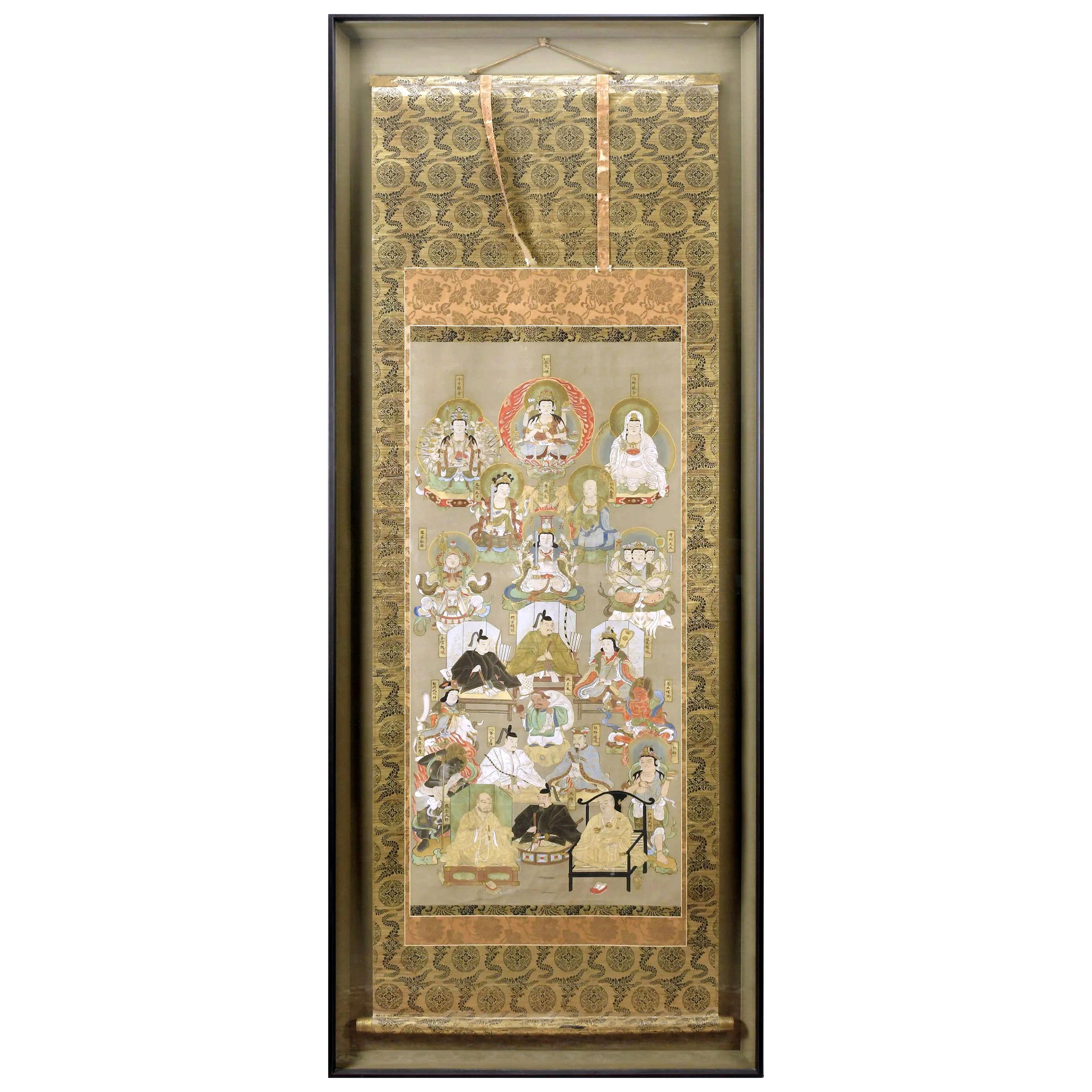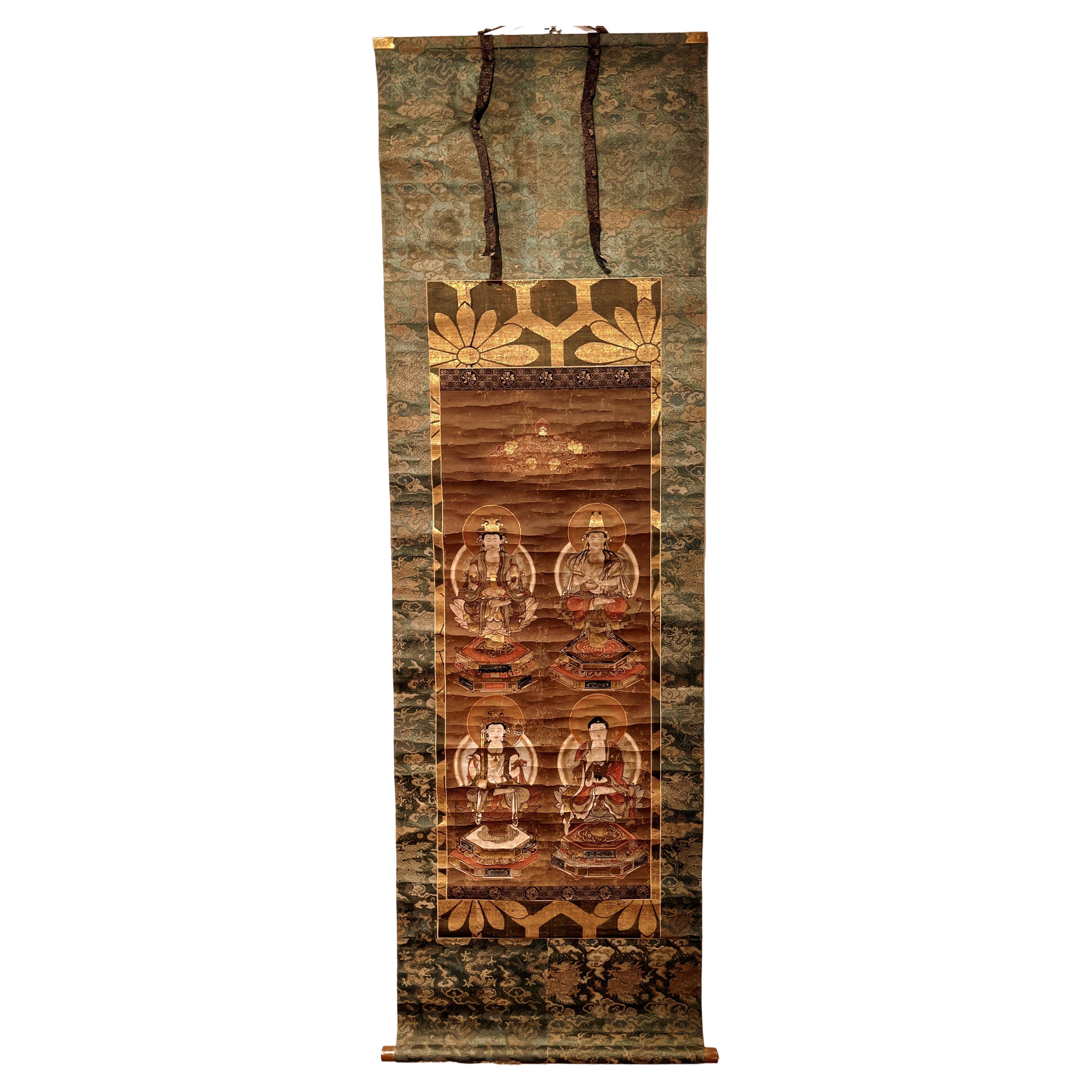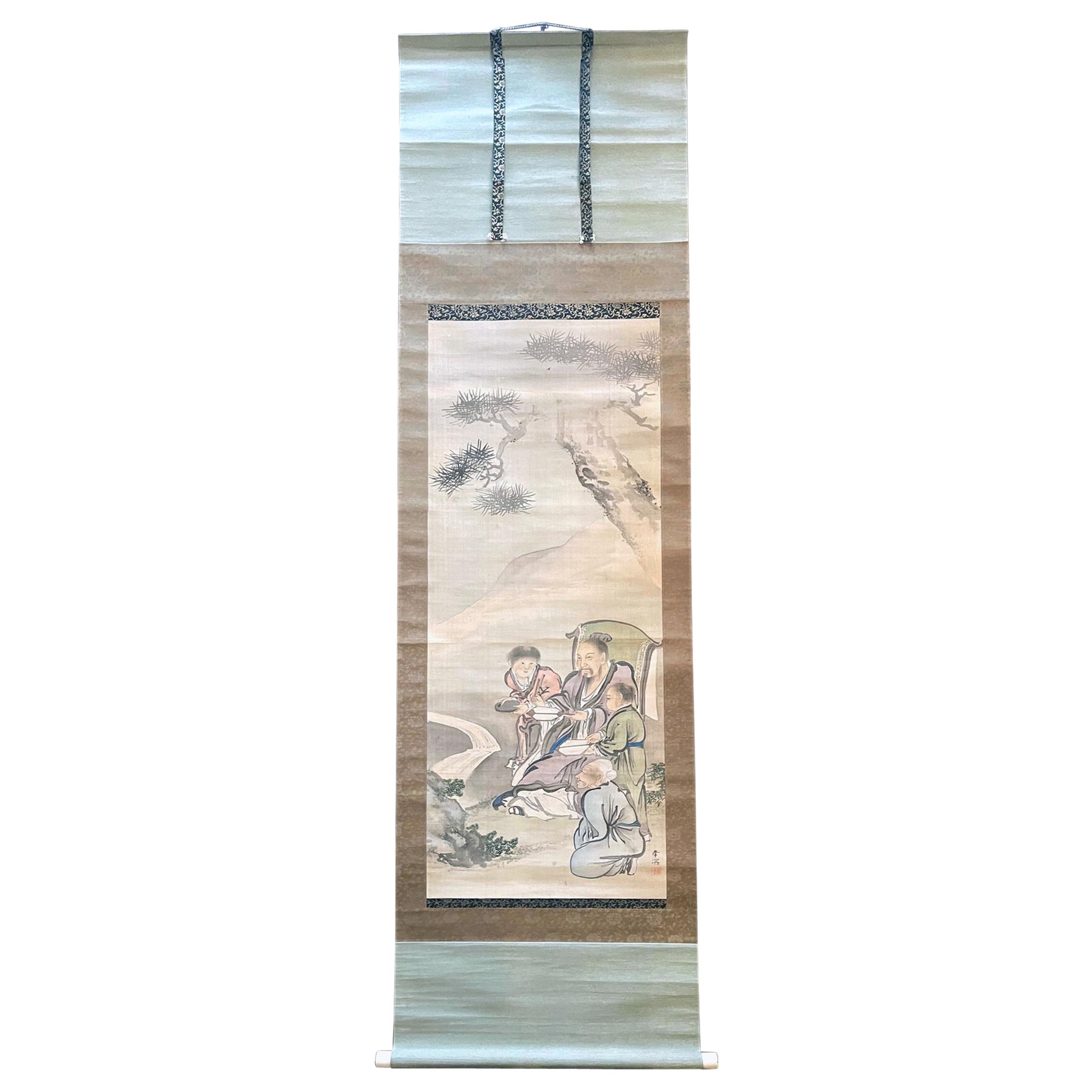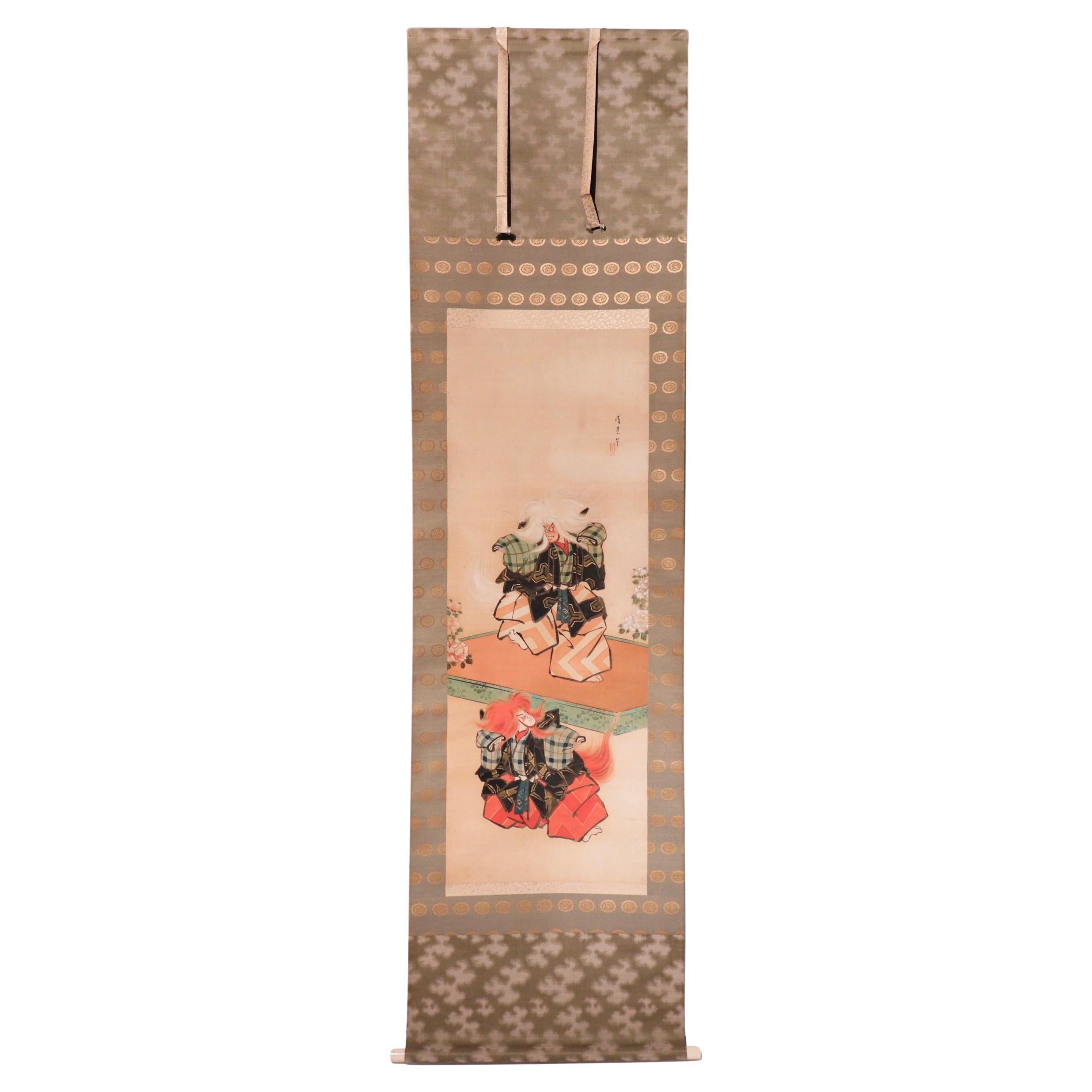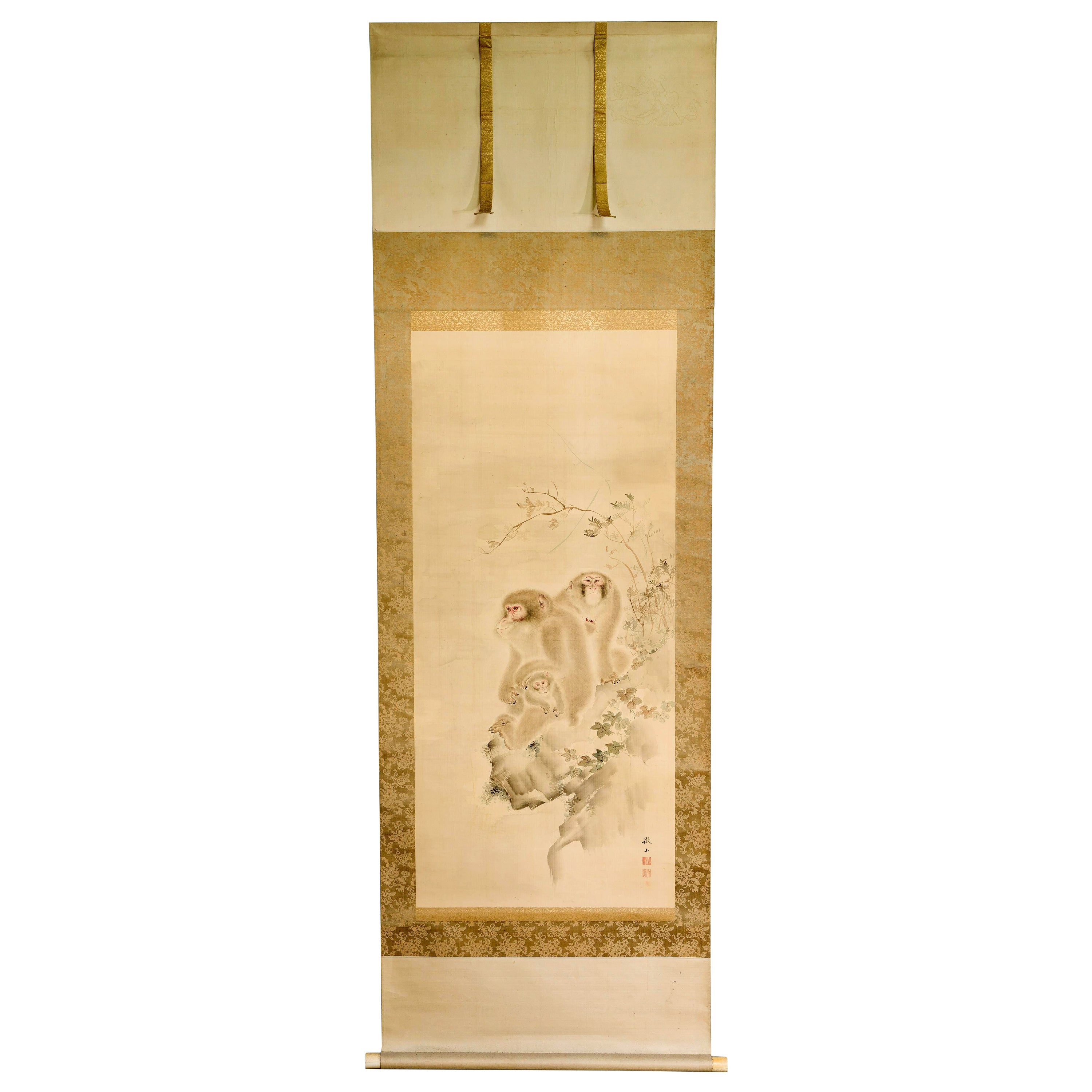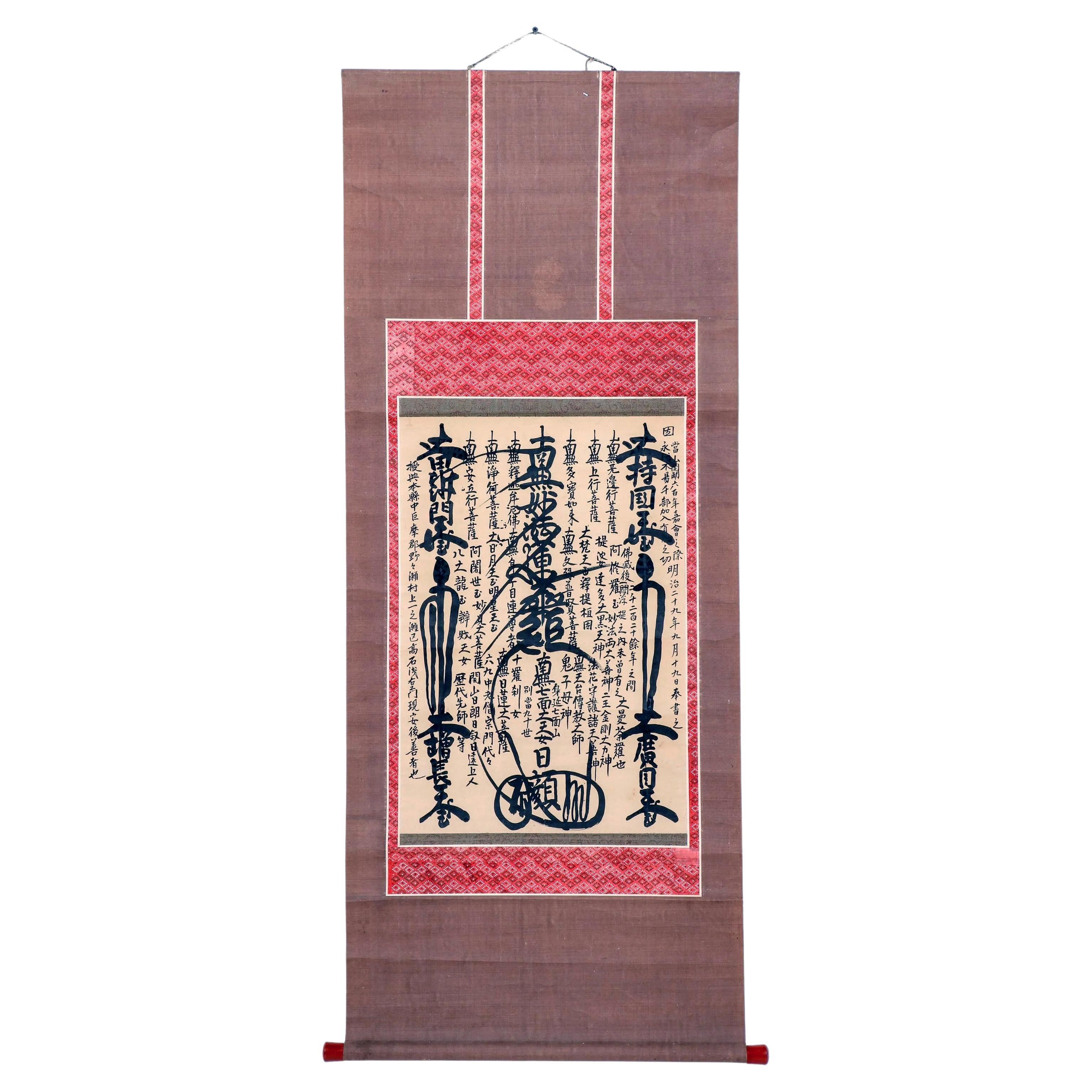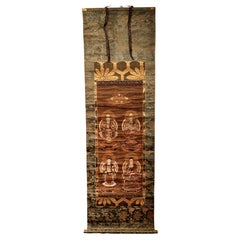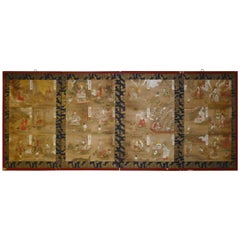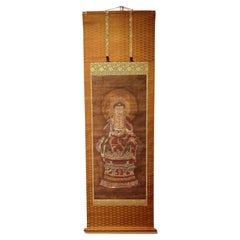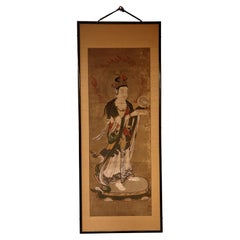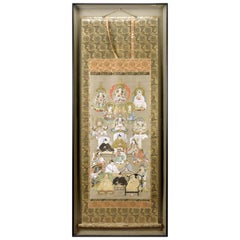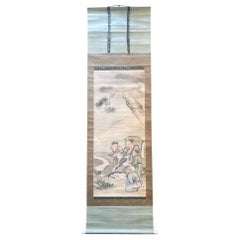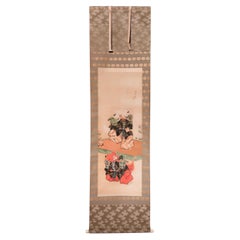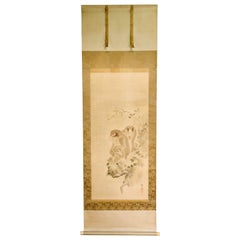Items Similar to Japanese Shito Religion of Four Deities, Scroll Painting
Want more images or videos?
Request additional images or videos from the seller
1 of 13
Japanese Shito Religion of Four Deities, Scroll Painting
$5,500
$7,50026% Off
£4,175.51
£5,693.8726% Off
€4,775.89
€6,512.5826% Off
CA$7,684.30
CA$10,478.5926% Off
A$8,546.62
A$11,654.4826% Off
CHF 4,462.78
CHF 6,085.6126% Off
MX$104,003.23
MX$141,822.5926% Off
NOK 56,996.48
NOK 77,722.4726% Off
SEK 53,452.64
SEK 72,889.9726% Off
DKK 35,644.29
DKK 48,605.8426% Off
Shipping
Retrieving quote...The 1stDibs Promise:
Authenticity Guarantee,
Money-Back Guarantee,
24-Hour Cancellation
About the Item
Japanese painting of Shito religion shrine depicted the four deities in court dress represent a hierarchy of local Shinto gods (kami) and with pair of guardian lions and lower stairway with white and black fox.
The upper pair comprises Kariba Myōjin (male) and Niu Myōjin (female), the gods of the mountain who welcomed the monk as he searched for a site on which to build a temple
Shinto religion is indigenous religious beliefs and practices of Japan and is the worship of nature and ancestors. The most important figures in the Shinto religion are the "kami," which are the Japanese Shinto gods.
The followers of Shintoism believe that spiritual powers exist in the natural world. They believe that spirits called "kami" live in natural places such as in animals, plants, stones, mountains, rivers, people
Color on silk. Acquired from Nagel, Germany early 2000
Overall size : 72.5" height 21.5" width
Image size: 39.5" height 16" width
- Dimensions:Height: 72.5 in (184.15 cm)Width: 21.5 in (54.61 cm)Depth: 1.5 in (3.81 cm)
- Materials and Techniques:
- Place of Origin:
- Period:
- Date of Manufacture:19th Century
- Condition:
- Seller Location:Greenwich, CT
- Reference Number:Seller: p15761stDibs: LU804235617152
About the Seller
5.0
Vetted Professional Seller
Every seller passes strict standards for authenticity and reliability
Established in 1996
1stDibs seller since 2005
390 sales on 1stDibs
Typical response time: <1 hour
- ShippingRetrieving quote...Shipping from: Old Greenwich, CT
- Return Policy
Authenticity Guarantee
In the unlikely event there’s an issue with an item’s authenticity, contact us within 1 year for a full refund. DetailsMoney-Back Guarantee
If your item is not as described, is damaged in transit, or does not arrive, contact us within 7 days for a full refund. Details24-Hour Cancellation
You have a 24-hour grace period in which to reconsider your purchase, with no questions asked.Vetted Professional Sellers
Our world-class sellers must adhere to strict standards for service and quality, maintaining the integrity of our listings.Price-Match Guarantee
If you find that a seller listed the same item for a lower price elsewhere, we’ll match it.Trusted Global Delivery
Our best-in-class carrier network provides specialized shipping options worldwide, including custom delivery.More From This Seller
View AllJapanese Buddhist Painting, Hanging Scroll Painting
Located in Greenwich, CT
Japanese Buddhist Painting , Hanging Scroll Painting
Depicted Amituofo and Budhisattva in the painting sitting on the lotus crown seats. Bea...
Category
Antique 19th Century Japanese Paintings and Screens
Materials
Paper
$3,800 Sale Price
34% Off
Japanese Buddhist Teaching Painting
Located in Greenwich, CT
Japanese Buddhist teaching painting, set of four paintings with 24 Buddhist stories with Japanese written characters in each story on one screen. Provenance: Purchased from Christie's South Kensington...
Category
Antique 1820s Japanese Edo Paintings and Screens
Materials
Paper
Japanese Buddhist Painting of Sitting on Lotus Crown, Scroll Painting
Located in Greenwich, CT
Japanese Buddhist Painting Sitting on Lotus Crown Seat
Ink and color on silk
Overall size : 25.6" width 81" height
Image size: 19.7" widt...
Category
Antique 19th Century Japanese Paintings and Screens
Materials
Silk
Japanese Brush Painting of a Standing Bodhisattva of Mercy
Located in Greenwich, CT
Japanese brush painting of a standing Bodhisattva of Mercy, beautiful colors and brush work, 19th century, original brocade mount
Category
Antique 19th Century Japanese Meiji Paintings and Screens
Materials
Paper
$2,500 Sale Price
30% Off
Japanese Landscape Painting, Hanging Scroll Painting
Located in Greenwich, CT
Japanese scroll painting of landscape painting depicted village along the riverside in the mountains with fisherman
Ink and color on silk
Overall size...
Category
Antique 19th Century Japanese Paintings and Screens
Materials
Silk
Japanese Painting of Mountain and village, Hanging Scroll
Located in Greenwich, CT
Japanese scroll painting depicted village in the mountain
Ink and paper. Artist signed
Overall size: 43" height. 21" width
Image size: 10.8" height. 16" width
Category
Vintage 1940s Japanese Paintings and Screens
Materials
Paper
You May Also Like
Japanese Silk Suijaku Scroll Nyorai-Kojin with Mixed Buddhism and Shinto Deities
Located in Atlanta, GA
A Japanese silk Suijaku hanging scroll beautifully presented in a custom wood shadow box frame from Edo period (circa 18-19th century). The scroll, surmounted on golden brocade was painted in fine details with gouache, ink and gold powder highlight, served as a Suijaku mandala for the worshippers. Honji Suijaku is a complicated religious concept uniquely developed in Japan. It mixed and hybrid the Buddism deities with native shinto spirits (known as Kami), which were seen as local manifestations (the suijaku, literally means a "trace") of Buddhist deities (the honji literally the original ground). The original idea may lie with the synergetic strategy to spread Buddism by making it more relatable to the local population who had already worshiped Shinto gods. The paradigm, adopted in the 10th century from an orignal Chinese concept, remained a defining feature of Japanese religious life up to the end of the Edo period (1868). Instead of being confined to deities, its application was often extended to historical figures as shown on this scroll.
This long hanging scroll depicts an arrangement of 21 figures including Buddhism and Shinto deities as well as two historical figures on the bottom. Each figure was name-tagged in Kanji for easy identification by the worshippers. It was used in the temple or shrine so that when the worshipper prayed in front the mandala, they prayed simultaneously to all the deities.
On the very top, sits Nyorai-Kojin, a hybrid deity of Nyorai Buddha and Kojin, the kaki for fire, stove and kitchen. From the top to bottom and left to right, here is the list of the deities: Kanon with Thousand Hands, Kanon with Willow Branch, Monju Bosatsu...
Category
Antique Early 19th Century Japanese Edo Paintings and Screens
Materials
Silk, Wood
Japanese Silk Scroll by Haruki Nanmei Edo Period
Located in Atlanta, GA
A Japanese hanging silk scroll by late Edo period painter Haruki Nanmei (1795-1878). The gouache painting was in the tradition of Kano school and depicts an old scholar dressed in lo...
Category
Antique 19th Century Japanese Edo Paintings and Screens
Materials
Silk, Paper
Japanese Noh/Kabuki Shakkyo painting, Torii Kiyotada
Located in Point Richmond, CA
Japanese colors, gofun and metallics on silk painting of Noh/Kabuki Dancers, depicting two figures of actors dancing in the play Shakkyo portraying a pair of shishi (lions), one on a...
Category
Early 20th Century Japanese Meiji Paintings and Screens
Materials
Silk
Japanese Silk Scroll Painting of Moneys Edo Period Mori Tetsuzan
Located in Atlanta, GA
A Japanese mounted vertical hanging scroll painting by Mori Tetsuzan (Japanese, 1775-1841) circa 19th century Edo period. The watercolor and ink on silk ...
Category
Antique 19th Century Japanese Japonisme Paintings and Screens
Materials
Silk, Paper
Japanese Gohonzon Buddhist Calligraphy Mandala Scroll Meiji Period
Located in Atlanta, GA
A Japanese sumi ink calligraphy Buddhist mandala mounted as a paper hanging scroll known as Kakejiku or sometimes Moji mandala. Termed as gohonzon in Japanese, it is a venerated object within Nichiren Buddhism (Hokkeshu; lotus sect). The originally concept was developed by the 13th century Buddhist priest Nichiren to guide the energy of the devotional chanting to...
Category
Antique 1890s Japanese Meiji Paintings and Screens
Materials
Paper
19th century Edo period's Hanging scroll Samurai players and child dancer
Located in Chiba, JP
Description - Hanging scroll with quite a surreal scene of the music and dance performance with two seated samurais and a child actor on a go-game-board who plays a role of dancing s...
Category
Antique Mid-19th Century Japanese Japonisme Paintings and Screens
Materials
Paper
More Ways To Browse
Scroll Painting
Fox Japanese
Asian Deity
Scroll Painting Silk
Japanese Scrolls Painting
Japanese Monk
Japanese Shrine
Lion Silk
Silk Japanese Scrolls
Antique Japanese Scroll Painting
Japanese Screens Mountains
Japanese Silk Dress
Japanese Lion
Pair Of Japanese Screens
Japanese Antique Shrines
Japanese Shinto
Asian Painted Scrolls
Stone Lion Pair
